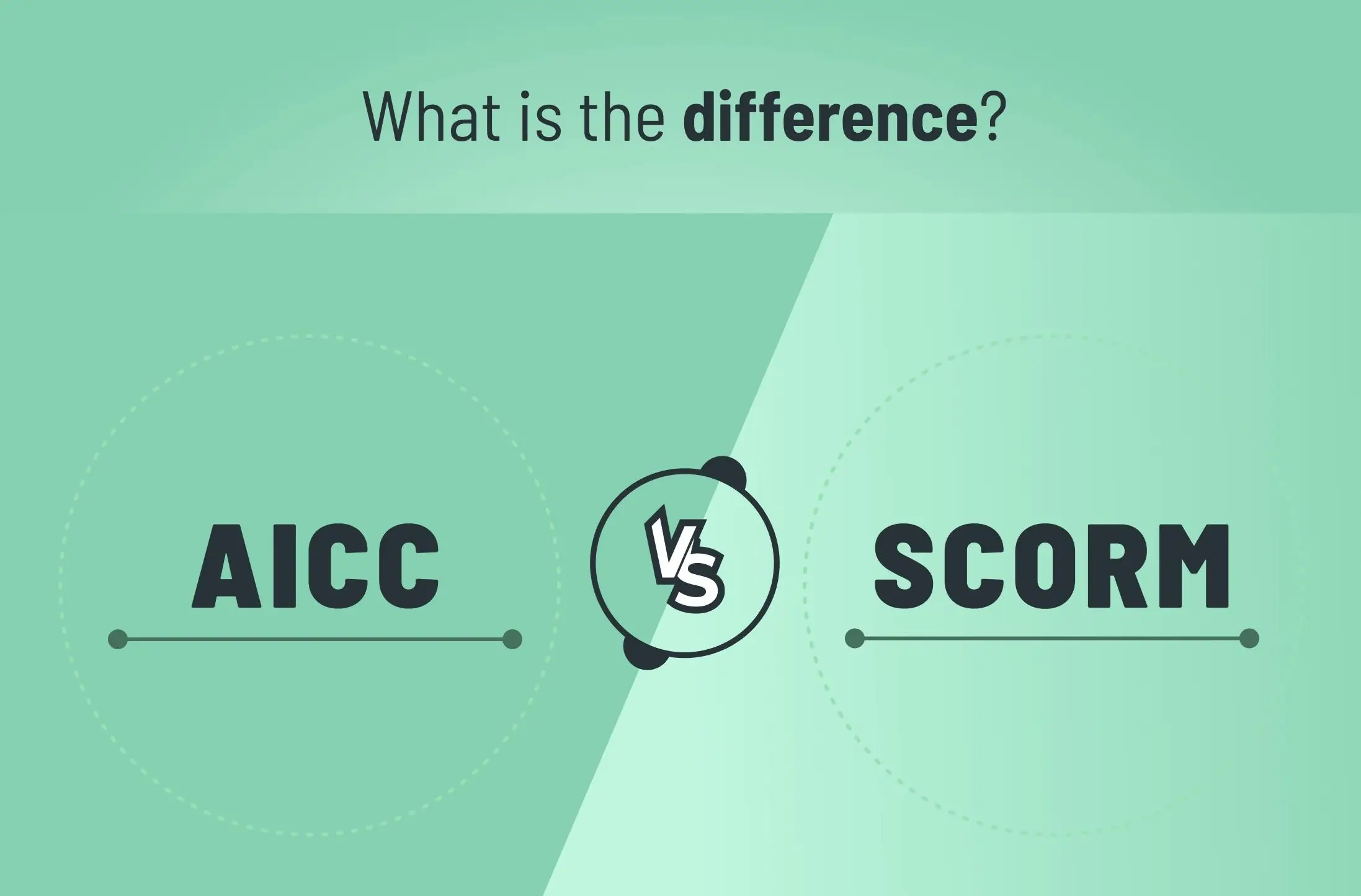In e-learning, various standards and protocols play a big role in ensuring interoperability and communication between different components of the learning ecosystem. One such standard that has significantly contributed to the evolution of eLearning is the Aviation Industry Computer-Based Training Committee (AICC) standard.
This article explores the concept of AICC, its role in the e-learning industry, and its relevance in the context of training and learning management protocols.
History and Origins of AICC
AICC emerged in the early 1990s, pioneering e-learning standards. Its legacy extends beyond aviation, spanning across diverse industries with a focus on learning system integration.
The development of AICC in the late 1980s in the aviation industry
So, what is AICC? In the early 1990s, AICC aimed to establish guidelines for computer-based training (CBT) programs in aviation. Its focus was on standardizing development and delivery for safety and compliance.
Over time, the AICC standard gained recognition beyond aviation, contributing to eLearning practices across various industries. Its notable legacy includes the AICC HACP standard, which defined communication protocols between learning management systems and content objects, ensuring interoperability. Although somewhat overshadowed by newer standards, AICC’s impact on common practices in CBT endures.
How AICC became the first e-learning standard for learning management systems (LMS)
The AICC technology strongly emphasizes the fundamental principles of learning system integration (LSI), striving for the seamless integration and compatibility of diverse learning systems. LSI dedicates itself to establishing a unified and harmonious learning environment by standardizing interactions among various learning systems, fostering a cohesive and interconnected educational experience.
Benefits of AICC
AICC pioneers eLearning interoperability through standards like AGR-006 and AGR-010, facilitating seamless communication between learning management systems and ensuring platform independence. Additionally, AICC prioritizes data security with the adoption of the HTTP protocol.
Interoperability: how AICC provides interoperability across platforms
The AICC standards were among the first to address eLearning interoperability. Particularly, the AGR-006 and AGR-010 standards enable various LMSs and content to communicate effectively. This interoperability ensures educational materials and training programs can operate across different platforms and systems without compatibility issues. The primary benefit is that organizations can choose from a wide range of software and tools without being locked into a single vendor.
Security: how the use of HTTP protocol ensures data protection
AICC’s adoption of the HTTP protocol for data communication enhances security in eLearning environments. By using HTTP, AICC standards ensure encrypted and secure data transfer between courseware and LMS. This protection is crucial for organizations handling sensitive or proprietary information, ensuring that learner data and course content remain confidential and safe from unauthorized access.
Comparison of AICC vs. Other Standards
With various standards being applied, AICC and the sharable content object reference model (SCORM) have played important roles. SCORM-compliant LMS platforms provide extensive e-learning features, while AICC offers enhanced security and flexibility, making both essential in different scenarios. While AICC boasts robust security and flexibility, SCORM’s widespread adoption offers comprehensive e-learning features.
AICC vs. SCORM: A comparative analysis
AICC, one of the earliest standards, focused on CD-ROM delivery and later evolved for web-based training. SCORM, however, was developed later and is more widely adopted today. It offers a more comprehensive set of standards and specifications for web-based e-learning, including tracking and bookmarking capabilities that AICC does not inherently provide.
What are the advantages and disadvantages of AICC vs. other standards?
- AICC advantages. AICC is known for its high level of security and its ability to function well in complex network environments. Also, its standards are less restrictive, offering greater flexibility in implementation.
- AICC disadvantages. It lacks some more advanced functionalities that SCORM offers, such as detailed tracking of learner progress and adaptability to a wider range of learning scenarios.
- SCORM advantages. SCORM is more universally adopted, making finding compatible content and systems easier. It also supports a wider range of e-learning features, like detailed tracking and reporting.
- SCORM disadvantages. Due to its more complex requirements, SCORM can sometimes be more challenging to implement in highly secure or specialized IT environments.
3 Steps to Integrate AICC into a Training Course
Embarking on effective AICC-compliant training necessitates careful platform selection, content development aligned with AGR-006 and AGR-010 standards, and seamless integration with a chosen LMS for optimal learning experiences.
1. Selecting a compatible platform for AICC
The first step is to choose an LMS that supports AICC standards. This involves researching and comparing different LMS providers to ensure they offer compatibility and can effectively communicate with AICC-compliant courseware.
2. Developing educational content tailored to AGR-006 and AGR-010 standards
Once a compatible LMS is selected, the next step is to develop or source educational content that adheres to AICC specifications, particularly AGR-006 and AGR-010. This may involve working with e-learning developers or instructional designers familiar with these standards to ensure the content is compatible and functions correctly within the LMS. Using professional instructional design services can help ensure that the content not only meets technical standards but is also pedagogically effective and engaging for learners.
3. Distributing the training course through a compatible LMS
The final step involves uploading and configuring the AICC-compliant courseware on the selected LMS. Besides, this includes setting up the course structure, ensuring proper communication between the courseware and the LMS, and testing to confirm that tracking and reporting features work as intended.
The Future of AICC in the E-learning Sphere
The AICC, dissolved in 2014, leaves an enduring mark on e-learning. Its early standards influenced subsequent specifications, with organizations still drawn to its security, cost-effectiveness, and flexible standards.
The legacy of AICC after its official dissolution in 2014
Despite its dissolution, AICC has left a significant legacy in the e-learning industry. Its early standards laid the groundwork for subsequent e-learning specifications and demonstrated the importance of interoperability and security in online education. Newer standards have integrated many of its principles and concepts, maintaining its influence in the industry.
Why some organizations continue to use AICC
Organizations continue to use AICC for several reasons. Its robust security features make it appealing to industries that handle sensitive information. Additionally, companies with existing AICC-compliant content and systems may find it more cost-effective to continue using these resources rather than transitioning to newer standards. Finally, the flexibility offered by AICC standards can be beneficial for specific types of training and educational scenarios, particularly in specialized industries.
Conclusion
AICC, serving as a standard intricately intertwined with the LSI standard, stands as a linchpin ensuring not only efficient training but also effective learning management and steadfast protocol adherence in the dynamic landscape of e-learning.
The adaptability inherent in AICC, coupled with its unwavering commitment to safety and substantial contribution to overarching technological advancements within the industry, firmly establishes it as a cornerstone shaping the trajectory of the future in e-learning.
Therefore, AICC emerges as a paramount player, wielding influence and significance that extend far beyond its immediate implications, influencing and steering the ever-evolving course of e-learning on a broader scale.






